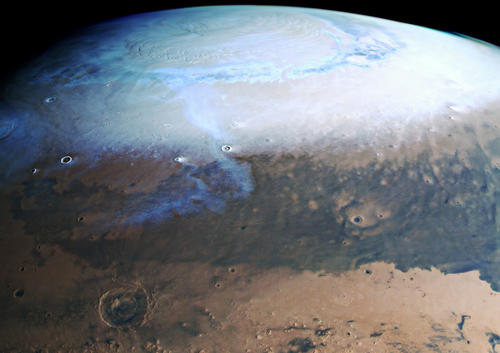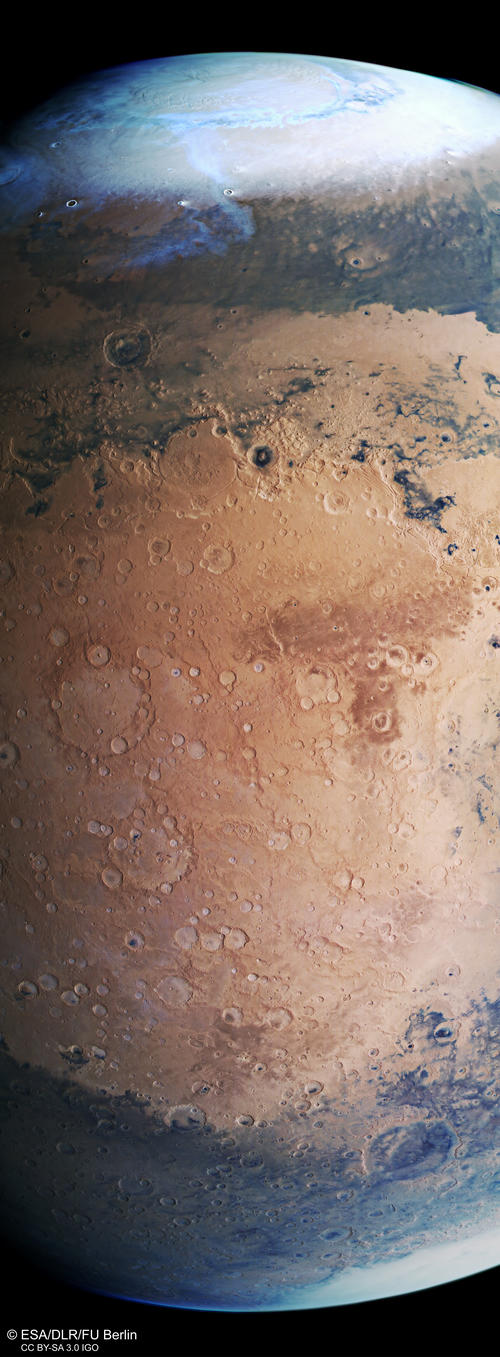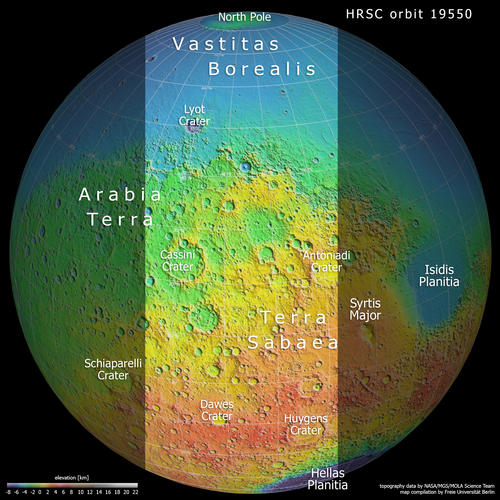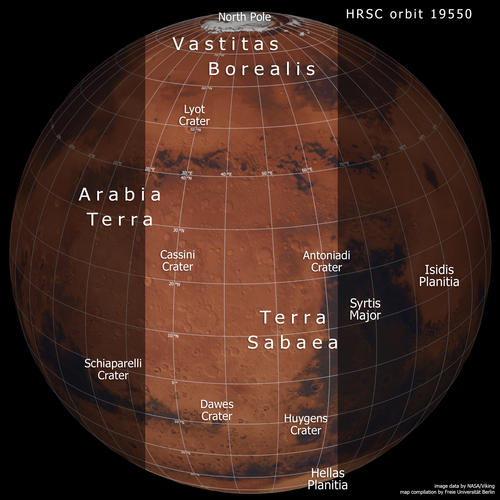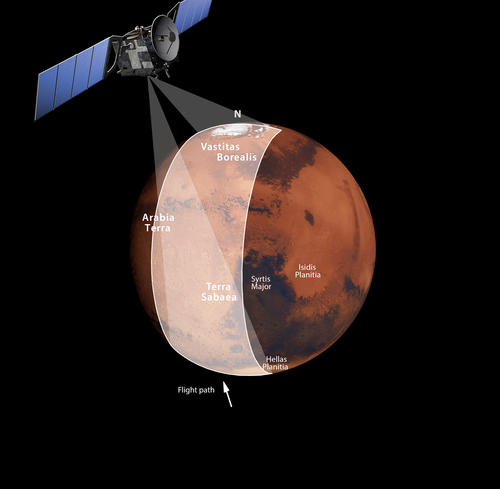Department of Earth Sciences
Service Navigation
Marvellous Mars – from the North Pole to the Southern Highlands
In June 2019, the High Resolution Stereo Camera (HRSC) captured several global views of Mars. The one presented here shows the northern hemisphere and the heavily cratered highlands around the equator of Mars. HRSC is a camera experiment that was developed and is operated by the German Aerospace Center (Deutsches Zentrum für Luft- und Raumfahrt; DLR), and mounted on board ESA’s Mars Express mission, orbiting Mars since 2003.
» Read more about this image in the main article and below the gallery ...
Marvellous Mars • Image
HRSC color image
Image Credit: ESA/DLR/FU Berlin
Marvellous Mars • Maps and Imaging Principle
MOLA Mars Map
HRSC orbit coverage on Mars Orbiter Laser Altimeter (MOLA) map
Image Credit: NASA/MGS/MOLA Science Team, FU Berlin
Viking Mars Map
HRSC orbit coverage on Viking map
Image Credit: NASA/Viking, FU Berlin
From the North Pole to the Southern Highlands
» Read more about the image and the Martian dichotomy
The upper part of this striking global view of Mars shows the northern hemisphere and the North Pole ice cap in winter. A thin veil of clouds stretches from there across the adjoining deep valleys, some of which are covered with dark sand. A prominent escarpment is visible in the image. This marks the border between Mars’ northern lowlands and its southern highlands. Dark sands also cover some areas of the crater-strewn highlands. In the extreme south (bottom) of the image, part of the Hellas impact crater is visible, covered by white clouds. The view of the planet is slightly tilted towards the south, allowing the North Pole to be seen, but it only extends down to 40 degrees south. The South Pole is therefore not visible. From pole to pole, Mars measures 6752 kilometres; the image shown here covers just under 5000 kilometres of that distance.
The reddish plains of Arabia Terra and Terra Sabaea in the centre of the image are notable for the presence of many large impact craters, indicating that they are among the oldest regions on Mars. Along their northern border is a striking escarpment, with a difference of several kilometres in height. This separates the flat, barely cratered plains of the northern lowlands from the southern highlands, which have many more craters. This remarkable change in terrain, referred to as the Martian dichotomy, marks a fundamental topographical and regional division on Mars. This is reflected, most importantly, in the different crust thicknesses, but also extends to the magnetic properties of the crust and its gravitational field. There is still a certain amount of scientific debate over how this crust dichotomy came about. It could have originated from endogenous forces in the Martian interior and thus been caused by mantle convection or tectonics. If exogenous (external) forces were responsible, this effect could perhaps be traced back to one or more major asteroid impacts.
The intensely rugged landscape at the dichotomy boundary has been severely eroded over millions of years, and is now characterised by numerous tectonic faults, mesas and river valleys. Observations have revealed that fluvial, aeolian and, in particular, glacial processes have altered the transition zone. Analysis of the image data suggests that there may have been several episodes of glacial activity during the evolution of Mars.
High Resolution Stereo Camera (HRSC)
» Information to image origin and processing
The images were acquired by the HRSC (High Resolution Stereo Camera) on 17 June 2019 during Mars Express Orbit 19550. The ground resolution in the center of the image is approximately one kilometer per pixel and the image is centered at 44° East and 26° North. The color image was created using data from the nadir channel, the field of view which is aligned perpendicular to the surface of Mars, and the color channels of the HRSC. The context maps are based on data of the Viking mission and of the Mars Orbiter Laser Altimeter (MOLA) experiment onboard the Mars Global Surveyor (MGS) mission of NASA.
The systematic processing of the camera data took place at the DLR Institute for Planetary Research in Berlin-Adlershof. The working group of Planetary Science and Remote Sensing at Freie Universität Berlin used the data to create the image products shown here.
HRSC color view of Mars: ESA/DLR/FU Berlin, CC BY-SA 3.0 IGO
Context map rainbow color: NASA/MGS/MOLA Science Team, FU Berlin
Context map Mars color: NASA/Viking, FU Berlin
HRSC imaging principle: FU Berlin/ESA/NASA
Copyright Notice:
Where expressly stated, images are licenced under the Creative Commons Attribution-ShareAlike 3.0 IGO (CC BY-SA 3.0 IGO) licence. The user is allowed to reproduce, distribute, adapt, translate and publicly perform it, without explicit permission, provided that the content is accompanied by an acknowledgement that the source is credited as 'ESA/DLR/FU Berlin', a direct link to the licence text is provided and that it is clearly indicated if changes were made to the original content. Adaptation/translation/derivatives must be distributed under the same licence terms as this publication.
The High Resolution Stereo Camera was developed at the German Aerospace Center (DLR) and built in collaboration with partners in industry (EADS Astrium, Lewicki Microelectronic GmbH and Jena-Optronik GmbH). The science team, which is headed by Principal Investigator (PI) Prof. Dr. Ralf Jaumann, consists of 52 co-investigators from 34 institutions and 11 countries. The camera is operated by the DLR Institute of Planetary Research in Berlin-Adlershof.
